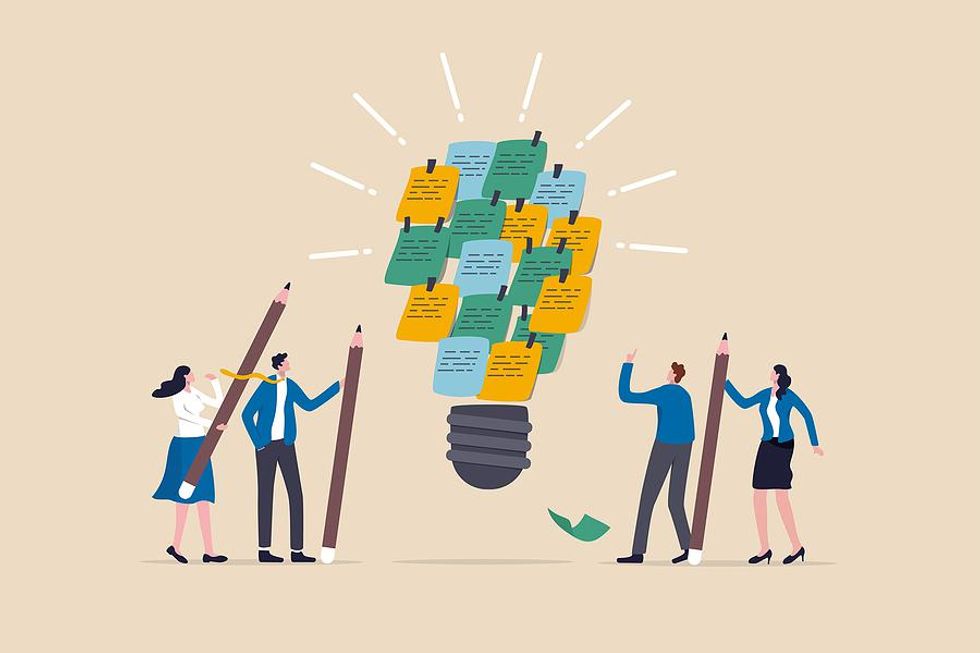
If two heads are better than one, then how about ten?
The pace of change is speeding up, as is the pace of business. This brings new problems to solve, more of them and faster than ever before. New problems demand new ideas. How do you generate these ideas quickly?
One method is the very old-fashioned but very effective brainstorming session.
People often talk about brainstorming, but not many people know how to run a brainstorming session.
It''s actually pretty straightforward.
A Simple Definition

A brainstorming session is a meeting between two or more people. One person presents a question to be answered or a problem to be solved. Everyone present thinks of many ways to solve the problem in a very short space of time. The organizer collates the ideas, then works with the group to choose the most useful, which are then used to formulate a plan.
The Process

This can be applied to any number of people in any setting. If followed properly, the whole thing can be finished in 20 minutes or less.
Brainstorming is quite a formal process. The formality is there for a reason. The rules make the process go faster.
Make sure that all participants know and understand how the process works before you begin. When running the brainstorming session, make sure all participants stick to the rules.
Step 1: Presenting The Problem
Present the problem to be solved as a question.
The question will usually be: 'How do we _____?' or 'The situation is _____. Now, what do we do?'
In a face-to-face setting, write the question on a whiteboard or flip chart. In a remote setting, write your question in the chat of your communications application.
Step 2: Generating Ideas
Tell the participants that you want their answers in two or three minutes. The urgency will motivate them to come out with the first things they think of, without their thoughts being filtered by notions of practicality, or by the fear of saying something 'stupid' or 'inappropriate.'
In a face-to-face setting, participants can call out their thoughts while a 'scribe' writes them down. This favors the more extroverted members of the group at the expense of the rest.
Alternatively, ask participants to write their idea on paper and hand those in. Where your brainstorming session is done remotely, people can write their ideas in the chat.
At this stage, the most important rule is that there is no such thing as a stupid idea. All participants'' ideas are equally as valuable. No one has the right to criticize someone else''s ideas.
This will give you more ideas than you need.
Step 3: Filtering Ideas
Here is one way for the team to filter out ideas that will not be adopted:
Assuming you have 10 ideas on the board/displayed on the screen, ask each participant to rank each idea with a number from 1 to 10, where 1 is for the best idea and 10 is for the worst idea.
Get them to call out their scores. Add them all up. The idea with the lowest total score is the 'winner.'
Select a second and third choice as well, in case some external factor prevents you from running with the first idea.
Get the team to vote on the most 'creative'/'original' idea as well. This cannot be included in the 'top 3' results.
'Creative' ideas may not always be immediately practical but may be possible later. Look at a suitcase from the 1960s. Why did it take so long for someone to put wheels on luggage?
What Next?

'Once you have your 'top 3,' then it''s up to you to decide what happens next.
Do you ask your team for a plan to bring the idea to fruition?
Do you ask them to write a proposal to pass up to senior management for approval?
That depends on the situation. Like any other conversation with a purpose, there should be a concrete result that is used in some way.
'Training' Your Team

If your team has never done brainstorming before, they may find it quite uncomfortable and not produce the best results the first time around.
It makes sense to use it for a less important topic first, like ideas for the next team event, just to get people comfortable with the format.
Benefits

As well as being a great way to generate ideas quickly, it can also be a bonding experience for the team. Participants will see a different side of their colleagues'' personalities and will actually work as a team, rather than as a collection of individuals who do more or less the same thing in the same office.
Over to you!
Your team is your 'collection of experts.' Think of your most pressing problem. Can you boil it down into a 'how' or 'what' question?
Set up the meeting, run the brainstorming session, and tell me how it went!









